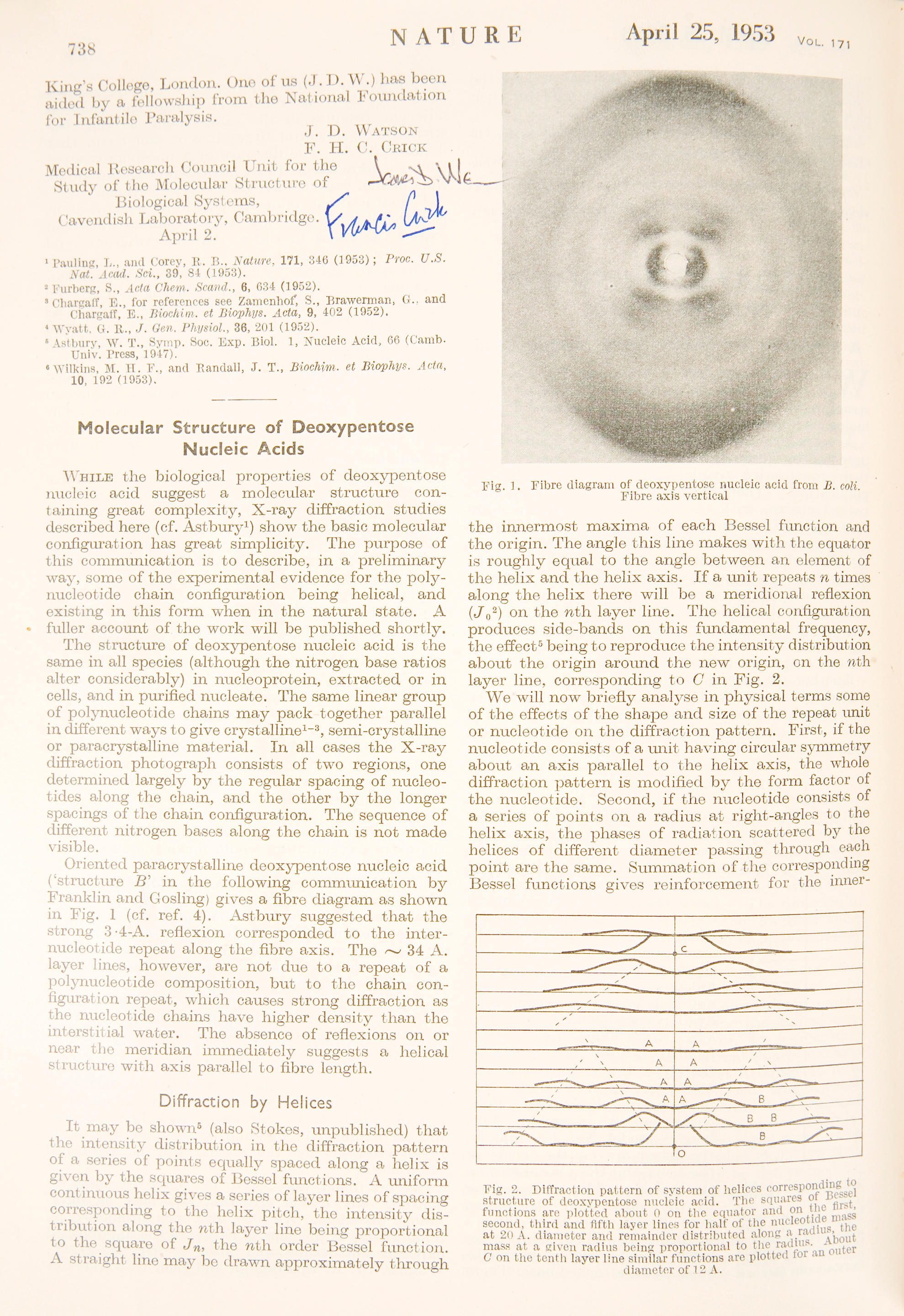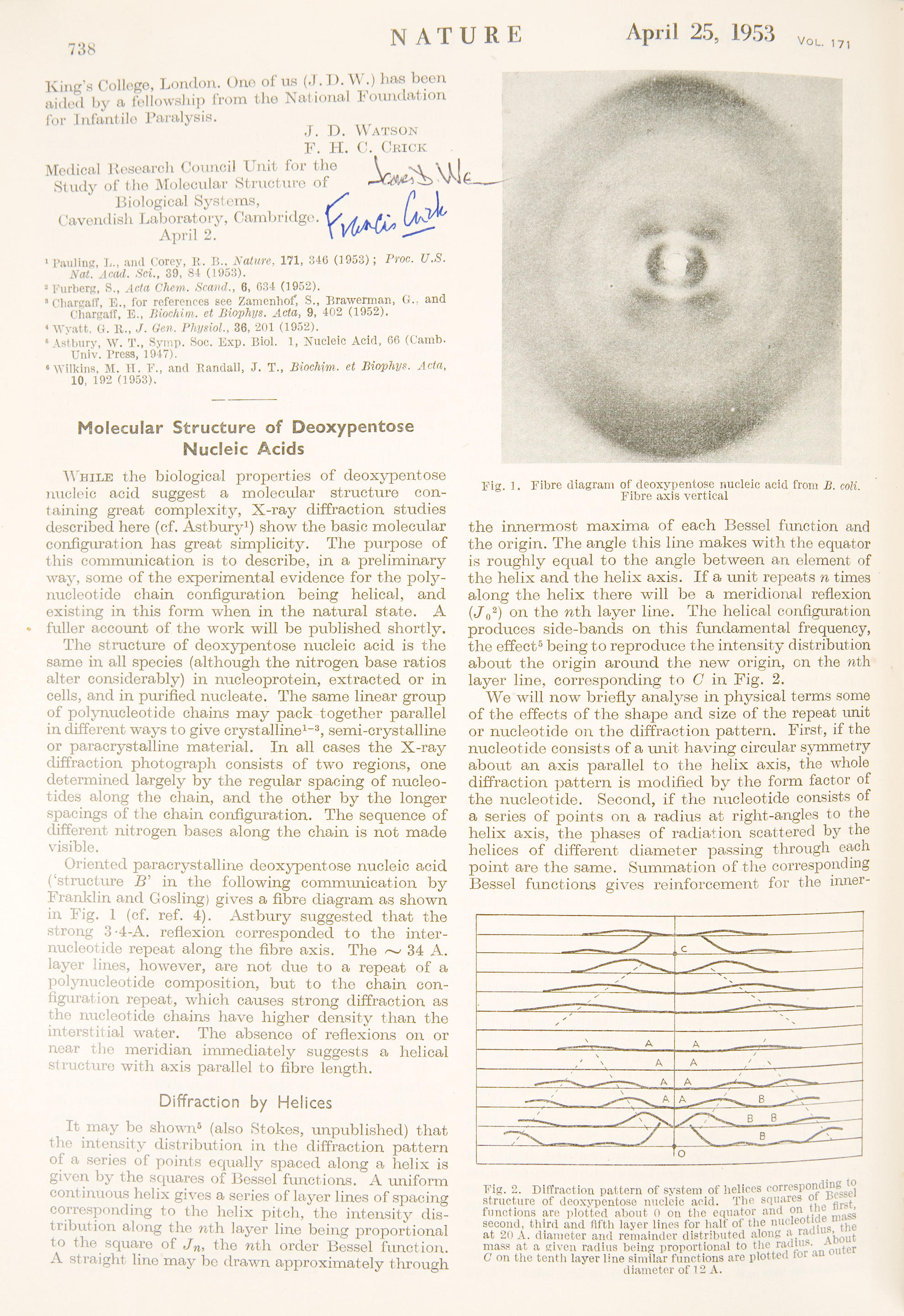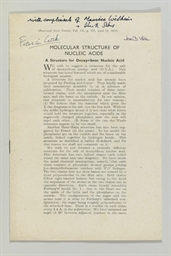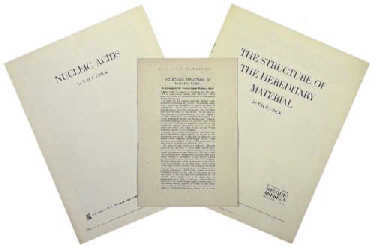WATSON, James and Francis CRICK. Genetical Implications of the Structure of Deoxyribonucleic Acid . Offprint from: Nature , vol. CLXXI, pp.964-967. [London]: Fisher, Knight & Co., Ltd for Macmillan & Co., Limited, 1953. 8° (210 x 140mm). Collation: [A] 2 χ 1 , one bifolium with a final leaf tipped onto the inner margin of [A]2v. 5 line illustrations. Modern gilt morocco backed clamshell box. FIRST EDITION, OFFPRINT ISSUE. WATSON AND CRICK'S RARE SECOND PAPER ON DNA, WHICH SETS OUT THE 'POSSIBLE COPYING MECHANISM FOR THE GENETIC MATERIAL' SUGGESTED IN THE FIRST PAPER AND PROPOSES THE SOLUTION TO 'ONE OF THE FUNDAMENTAL BIOLOGICAL PROBLEMS -- THE MOLECULAR BASIS OF THE TEMPLATE NEEDED FOR GENETIC REPLICATION'. SIGNED 'FRANCIS CRICK' AND 'PETER PAULING' ON P.[1]. Watson and Crick's first paper 'Molecular Structure of Nucleic Acids' (dated 2 April 1953 and published in the 25 April 1953 issue of Nature ), proposed the hypothetical structure of DNA; implicit in this structure was the mechanism for DNA's reproduction. As Watson and Crick state in the present paper of 30 May 1953, 'Previous discussions of self-duplication have usually involved the concept of a template, or mould. Either the template was supposed to copy itself directly or it was to produce a "negative", which in its turn was to act as a template and produce the original "positive" once again. In no case has it been explained in detail how it would do this in terms of atoms and molecules' (pp.4-5). Once the structure had been discovered, the method of replication seemed obvious, but the two scientists debated the wisdom of advancing their argument so far, and they decided to record the direction in which their thoughts were moving, whilst postponing the publication of the second hypothesis until the first was consolidated. As Watson states in The Double Helix (London: 1968), 'For a while Francis wanted to expand our note [i.e. the first paper] to write at length about the biological implications. But finally he saw the point to a short remark and composed the sentence: "It has not escaped our notice that the specific pairing we have postulated immediately suggests a possible copying mechanism for the genetic material"' (p.220), and Watson later expanded on this in Genes, Girls and Gamov (Oxford: 2001): 'Francis had initially wanted to be much more specific in our April 25 paper, but I argued that we should understate our model's implication because our paper was to be followed by ones from Rosalind Franklin's and Maurice Wilkin's groups [cf. the previous lot], the two having long gone their separate ways' (p.11). However, Watson soon came to appreciate Crick's concerns: 'Once our manuscript [of the first paper] had gone to Nature , I, too, worried that if we didn't state our ideas more clearly somebody else would try to poach them and get some of the credit. Francis wrote most of this second manuscript, which we called "Genetical Implications of the Structure of Deoxyribonucleic Acid". We had less than a week to complete it and as soon as we had finished the drawings it went off with Sir Leonard Bragg's imprint to appear in the 30 May issue of Nature ' ( loc . cit .). Thus, the true importance of their work is given its fullest expression by the two papers together; the opening statement of the first -- 'We wish to propose a structure for the salt of deoxyribose nucleic acid (D.N.A.). This structure has novel features which are of considerable biological interest' -- finds its fulfillment in the conclusion of the second paper: 'Despite these uncertainties we feel that our proposed structure for deoxyribonucleic acid may help to solve one of the fundamental biological problems -- the molecular basis of the template needed for genetic replication'. The present copy is signed not only by Crick, but also by Peter Pauling, who played a important part in the race to discover the structure of DNA and achieve priority of publication. Peter Pauling was the son of the doub
WATSON, James and Francis CRICK. Genetical Implications of the Structure of Deoxyribonucleic Acid . Offprint from: Nature , vol. CLXXI, pp.964-967. [London]: Fisher, Knight & Co., Ltd for Macmillan & Co., Limited, 1953. 8° (210 x 140mm). Collation: [A] 2 χ 1 , one bifolium with a final leaf tipped onto the inner margin of [A]2v. 5 line illustrations. Modern gilt morocco backed clamshell box. FIRST EDITION, OFFPRINT ISSUE. WATSON AND CRICK'S RARE SECOND PAPER ON DNA, WHICH SETS OUT THE 'POSSIBLE COPYING MECHANISM FOR THE GENETIC MATERIAL' SUGGESTED IN THE FIRST PAPER AND PROPOSES THE SOLUTION TO 'ONE OF THE FUNDAMENTAL BIOLOGICAL PROBLEMS -- THE MOLECULAR BASIS OF THE TEMPLATE NEEDED FOR GENETIC REPLICATION'. SIGNED 'FRANCIS CRICK' AND 'PETER PAULING' ON P.[1]. Watson and Crick's first paper 'Molecular Structure of Nucleic Acids' (dated 2 April 1953 and published in the 25 April 1953 issue of Nature ), proposed the hypothetical structure of DNA; implicit in this structure was the mechanism for DNA's reproduction. As Watson and Crick state in the present paper of 30 May 1953, 'Previous discussions of self-duplication have usually involved the concept of a template, or mould. Either the template was supposed to copy itself directly or it was to produce a "negative", which in its turn was to act as a template and produce the original "positive" once again. In no case has it been explained in detail how it would do this in terms of atoms and molecules' (pp.4-5). Once the structure had been discovered, the method of replication seemed obvious, but the two scientists debated the wisdom of advancing their argument so far, and they decided to record the direction in which their thoughts were moving, whilst postponing the publication of the second hypothesis until the first was consolidated. As Watson states in The Double Helix (London: 1968), 'For a while Francis wanted to expand our note [i.e. the first paper] to write at length about the biological implications. But finally he saw the point to a short remark and composed the sentence: "It has not escaped our notice that the specific pairing we have postulated immediately suggests a possible copying mechanism for the genetic material"' (p.220), and Watson later expanded on this in Genes, Girls and Gamov (Oxford: 2001): 'Francis had initially wanted to be much more specific in our April 25 paper, but I argued that we should understate our model's implication because our paper was to be followed by ones from Rosalind Franklin's and Maurice Wilkin's groups [cf. the previous lot], the two having long gone their separate ways' (p.11). However, Watson soon came to appreciate Crick's concerns: 'Once our manuscript [of the first paper] had gone to Nature , I, too, worried that if we didn't state our ideas more clearly somebody else would try to poach them and get some of the credit. Francis wrote most of this second manuscript, which we called "Genetical Implications of the Structure of Deoxyribonucleic Acid". We had less than a week to complete it and as soon as we had finished the drawings it went off with Sir Leonard Bragg's imprint to appear in the 30 May issue of Nature ' ( loc . cit .). Thus, the true importance of their work is given its fullest expression by the two papers together; the opening statement of the first -- 'We wish to propose a structure for the salt of deoxyribose nucleic acid (D.N.A.). This structure has novel features which are of considerable biological interest' -- finds its fulfillment in the conclusion of the second paper: 'Despite these uncertainties we feel that our proposed structure for deoxyribonucleic acid may help to solve one of the fundamental biological problems -- the molecular basis of the template needed for genetic replication'. The present copy is signed not only by Crick, but also by Peter Pauling, who played a important part in the race to discover the structure of DNA and achieve priority of publication. Peter Pauling was the son of the doub




.jpg)

.jpg)
.jpg)
.jpg)






Try LotSearch and its premium features for 7 days - without any costs!
Be notified automatically about new items in upcoming auctions.
Create an alert